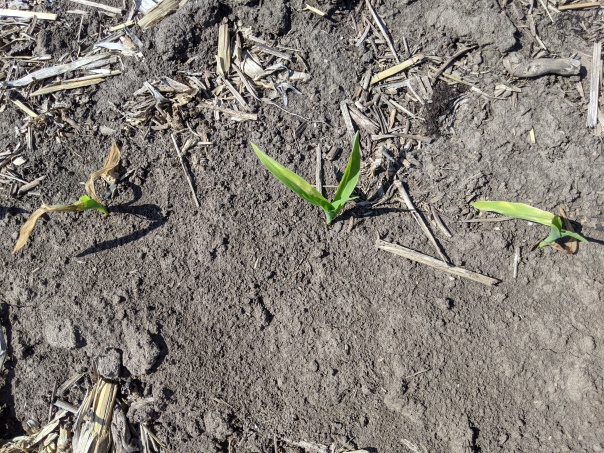| May free farm finance & legal clinics May 18: Land Mangement Quarterly: Trends for cash rent in 2020, Noon (CST), https://agecon.unl.edu/landmanagement June 24: Weed Management Field Day, SCAL near Clay Center July 8: Palmer Amaranth Mgmt Field Day, near Carleton Aug. 11: Soybean Management Field Days, Hildreth Aug. 12: Soybean Management Field Days, Elgin Aug. 13: Soybean Management Field Days, Shelby Aug. 14: Soybean Management Field Days, Arlington Aug. 20: Midwest Soil Health Clinic, ENREC Aug. 25: SCAL Field Day, Clay Center Aug. 26: Midwest Soybean Production Clinic, ENREC Aug. 27: Midwest Corn Production Clinic, ENREC |
Congratulations to all who graduated from college or high school the past few weeks! You’ve experienced much challenge, change, and loss. Good can come from difficulty! May this experience better equip you for the future! Also wish to congratulate and welcome three new team members to the York and Seward county offices! Tanya Crawford will begin as the 4-H Educator in York County May 18. Emily Hemphill began as the 4-H Assistant in Seward County May 1. Kara Kohel will begin as the new Learning Child Educator in Seward County June 1.
Crop Update: Grateful for the recovery experienced on many frost/freeze damaged crops throughout the State! The worst damage I saw on corn in this part of the State resulted in exposed leaf tissue dying with new growth coming out of the ground within 5 days. Soybeans fared well in the area to which I’m extra grateful with the large number of early planted soybean acres this year!
There’s been some talk about uneven emergence in some fields. Most really aren’t too bad, just worse in fields that were worked or extra cloddy. And most often, seedlings are still coming when digging in the gaps. They’re just behind most likely due to depth or soil moisture variation. You may also want to check out an article on Early Season Insects in this week’s CropWatch at cropwatch.unl.edu. Also seeing and hearing of ammonia burn to roots of corn seedlings, mostly in strip till situations, due to the dry conditions. An inch or two of rainfall or irrigation can help dilute the salt concentration in the root zone and allow for growth of roots to resume. I realize this doesn’t help those without irrigation and we keep praying for rain. In a 2009 trial at UNL South Central Ag Lab near Clay Center, Dr. Richard Ferguson documented those plants being shorter in stature and appearing to have a purple color early in the growing season before later recovering.
For those asking about replanting, we have two articles to aid in decision making in this week’s CropWatch at cropwatch.unl.edu. I haven’t seen situations warranting this around here yet. It takes quite a stand loss. For example in corn, if there are 25,000 plants per acre and the field was initially planted on April 27 and you cannot replant until May 20, it would be better to leave your present stand, which has 95% yield potential, than to replant on May 20 when the yield potential for a stand of 30,000 would be 86%. Make sure you consider replant costs in your decision. Next week I’ll address thoughts on post applications to crops.
Lawn Update: As lawns grow, it’s important to not remove more than 1/3 of the height. During the spring and fall, cool season grasses such as bluegrass and fescue are also building their root reserves. Removing too much growth at once or continually mowing shorter than 3” puts more stress on the plant and doesn’t allow for as deep of roots for when the summer heat comes. UNL turf research found that lawns actually grow faster when they are scalped than when they are mowed at a taller height. So, if your lawn gets away from you like mine did last week, do your lawn a favor and raise your mowing height that one time and then go back to mowing at 3”.
Youth Learning Opportunities: There are a number of virtual and self-paced fun, learning opportunities for youth and families upcoming in the month of June! Many of the activities that were provided during the school year will be continuing with new sessions. You can check them all out at: https://4h.unl.edu/virtual-home-learning.
Building Better Babysitters Virtual Training: Additional childcare may be needed this summer. Babysitting is a big responsibility and it’s not for everyone. Youth ages 11 and up who are interested in building skills as a babysitter may be interested Nebraska Extension’s state-wide virtual babysitting training. Register by going to https://cvent.me/d4gWeD.
Adding some pics on frost recovery:

Same growth stage but showing the environmental variability associated with frost damage.

Seedling affected by frost on 3/9/20. Leaves watersoaked and wilted two days later. Splitting open stem reveals a healthy growing point (not brown or mushy) and green, healthy tissue below the wilted tissue. Thus, plants like these will likely recover, but it’s best to continue watching them for regrowth.

Same field 5 days later. A little sunshine and plants are recovering nicely! The frost-damaged tissue is now brown, dead and will typically slough off with the wind. Sometimes, it wraps around the seedling making it more difficult for new growth to push through at first, but it will.

Emerged beans were essentially unaffected in anything I looked at for this part of the State and are looking great now!


































